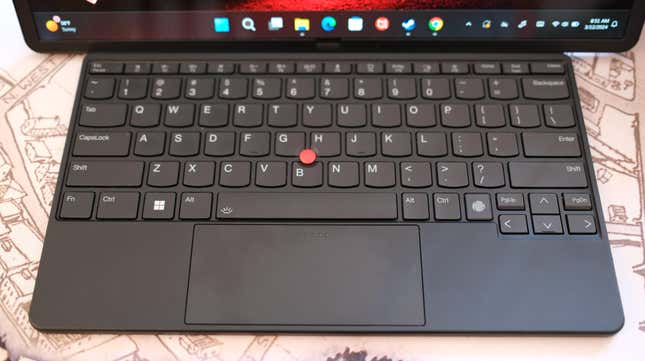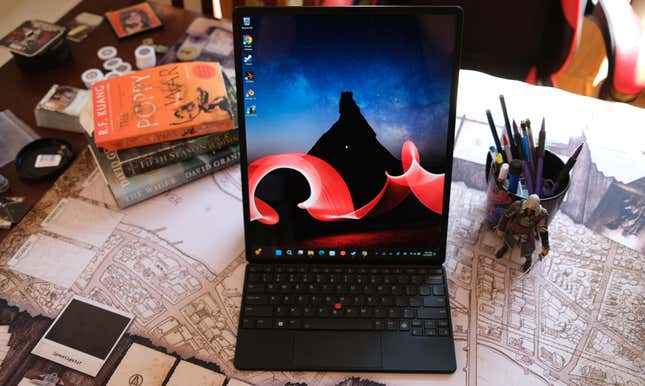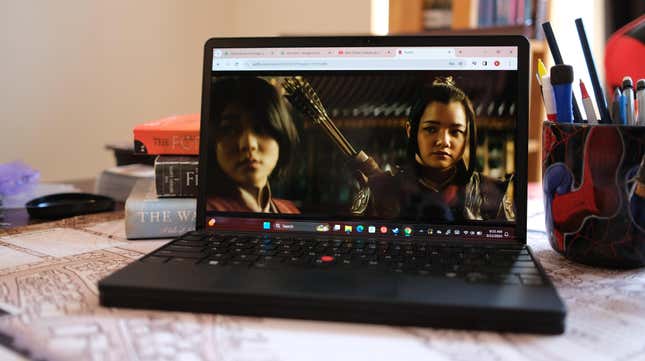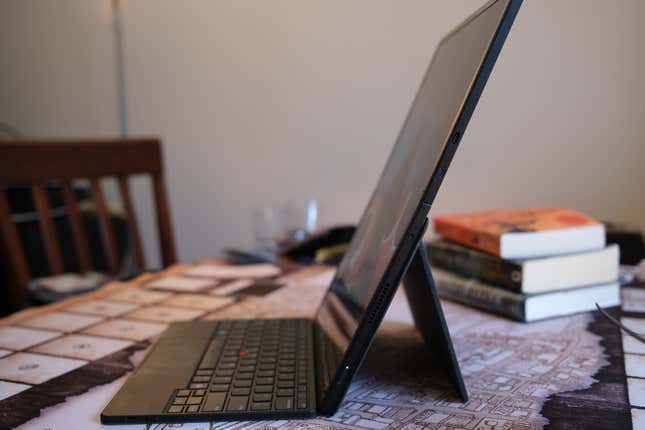
Lenovo ThinkPad X1 Fold 16 Review
Lenovo ThinkPad X1 Fold 16
While it certainly folds up small, the newest iteration of the X1 Fold still seems stuck in the past, which doesn’t bode well for future foldable PCs.
The Lenovo ThinkPad X1 Fold 16 has made solid gains on its first 2020 iteration but hasn’t taken all the best cues from other attempts at foldable PCs. It’s using an older 12th-gen Intel CPU that doesn’t have enough power for most tasks beyond basic productivity. It’s got a nice screen and darn good battery life, but at its price, you should look elsewhere for an ultra-portable PC.
Starting at $2,500 (Reviewed at $3,900)
Pros
A very nice screen with little to no crease
Good sound that works no matter which mode it’s in.
Has a battery life to support for a full work day.
Cons
High price for any kind of productivity laptop
A past-gen CPU holds back its performance
It hasn’t innovated enough to make a good case for foldable PCs
Foldable phones have managed to create their own niche in the smartphone market. They’re some of the most expensive mobile devices you can buy, but at the very least, they’ve put on their big boy swim trunks and now, at least, can doggy paddle around with the rest of the mature smartphones. Foldable PCs, on the other hand, are still treading water. Lenovo has had the chance to climb into the deep end with large-scale squashable screens, but the company only went ankle-deep with its latest ThinkPad X1 Fold redesign.
The ThinkPad X1 Fold first appeared in 2020 with its surprisingly dim 13-inch OLED screen. While it was a novel product at the time with a lot of innovative ideas, we didn’t feel that the first foldable PC’s usability matched its ambition. Lenovo was the first company to put this kind of design out, and anybody could buy it, so the attempt was admirable. Lenovo declared it tried again with the Fold 16, showing it off in the middle of 2022, but for whatever reason, the laptop only saw commercial release at the end of 2023.
Much has changed in four years since we first glimpsed the rough-edged, ambitious X1 Fold. We’ve seen the Asus ZenBook 17 Fold OLED try and fail to hit the mark with a very similar design to Lenovo’s. HP tried again with its $5,000 Spectre Fold, marred by its low power for its high price tag. The ThinkPad X1 Fold 16 tries a few new things, yet Lenovo hasn’t capitalized on other company’s innovations in the same field. Worse, I still don’t see how a slightly smaller clamshell that grows into a slightly bigger screen beats the ‘ye ol’ laptop design long since honed to near perfection.
Instead, we have a 16-inch pseudo-desktop that can fold into a 12-inch, though heavy, book-like product. It folds mostly flat, but there’s a gap where potential particles can get through to harm the sensitive inner screen. The ThinkPad X1 Fold is okay on a desktop and is acceptable as a small-sized, low-power laptop, but it just doesn’t work well as a tablet unless you wish your iPad were dense enough to fly like a brick through your neighbor’s window.
But at its price, it’s more novelty than anything. It starts at $2,500, yet it’s sporting a 12th-Gen Intel Core i7-1260U. It would have been a rather basic, low-power CPU two years ago, but in 2024, it’s practically an antique. It’s enough to power your basic browsing tasks, but not much more than that. The Fold does have a relatively lovely OLED screen. However, I would argue you’d be better off with a ThinkPad X1 Carbon, which also sports an excellent OLED display, if you’re dead set on getting a ThinkPad-brand laptop—though I should add we were also concerned about that model’s performance.
The Fold could be more like a traditional convertible akin to the Microsoft Surface or Lenovo’s Yoga series. But even in that regard, the X1 Fold fails to go toe-to-toe thanks to the tiny trackpad and constricted keyboard. The company may need to go back to the drawing board on its foldable PC design. The company is certainly not one to eschew innovation. Just take a quick gander at the hybrid Android and Windows ThinkBook Plus Gen 5 Hybrid or the Legion Go handheld console. But for something that costs more than $2,500, you need more than novelties and a bare few innovations to justify the price.
Lenovo ThinkPad X1 Fold Utility and Design
The Keyboard and Trackpad are Both a Pain to Use

There are a few clever design choices on the X1 Fold. The magnets attached to the stand are sturdy, and the attachment points to the Precision Pen are also strong enough to keep everything together when jostled in a backpack.
I hate creases on foldable devices. My favorite foldable device from last year was the OnePlus Open. It managed to minimize the crease down to a bare sliver. The ThinkPad X1 Fold doesn’t have a “crease” in the traditional sense, as in there’s not an especially noticeable bevel that catches the light and distracts you from your work. You won’t feel any gulley if you run the smart pen across the screen. Still, the screen doesn’t unfold to a perfect 180 degrees, more like 177. It’s especially noticeable when you’re holding it like a tablet. Still, Lenovo is another company that has proven you can design foldables without a crease.
Then things start getting weird. If you’re using the Fold in its standard Landscape mode, then the 1440p camera is tilted 90 degrees on the left side of the device. You can turn the laptop into Portrait Mode to have an extra long vertical screen to get the webcam back on top, but you can’t access the volume buttons anymore. If you take a video call in landscape mode, you’re sometimes forced to adjust your settings to flip your screen so your coworkers don’t think you’re about to fall out of frame. And all this time, no matter which way you orient the screen, you’ll be covering up at least one button or port.
And that’s all before you get to the keyboard. Bluetooth connects it, so you could technically use your own stand and keyboard, but this one’s explicitly designed for this PC. Lenovo described its design as a “full-sized keyboard,” but it feels far more cramped than I would like. I have to angle my hands to ensure they fit on the palm rests, and I’m not about to type hover-hand style. The low-profile keys feel fine to type on but won’t make any ThinkPad superfans go gaga over this shrunken version of Lenovo’s lauded keyboards.
The keyboard also keeps a separate charge from the main screen, meaning you’ll need a separate cable if both start losing juice. I found that the keyboard falls asleep if you don’t use it for too long, meaning you’ll need to press a button to reawaken it. Considering other foldable laptops like the $5,000 HP Spectre Fold used induction coils to charge the keyboard when connected to the main screen, it’s all such a strange design. The wonky Asus Zenbook Duo also sticks the keyboard between its dual screens for easy portability.
The haptic trackpad is minuscule, a little less than 4.25 by 2 inches. It’s a hand-cramping size that’s best ignored entirely in favor of the touchscreen or wiggle the big red “nipple,’ AKA the TrackPoint navigator, that ThinkPad fans may still enjoy. Although it has the same dimensions as the laptop folded up, you can’t clamp the fold around the keyboard like with other recent foldable PC designs. Everything attaches via magnets, so you’ll need to adhere the keyboard to the back of the main screen body during transit to carry it around.
The hinge on the X1 Fold reminds me first of the first Google Pixel Fold, which, of the many foldable devices that came out in 2023, easily had the worst hinge design of the lot. The new hinge on the X1 Fold is better than the previous version in 2020, and the Pixel and the bezels aren’t so bad compared to similarly-sized laptops. It all is a bit of a compromise to protect the sensitive foldable screen. That said, the frame is a carbon fiber magnesium alloy that does feel pretty strong, and I didn’t have any issues with regular wear and tear after more than a week of use and travel.
And while you can probably feel safe about it dropping from your hands, you’d be reluctant to use it like a tablet. It’s certainly a sturdy design, especially the outside aluminum with the slick-looking woven fabric, but it’s relatively heavy for its small size. Sure, it’s 2.78 pounds without the keyboard, but it’s 4.16 pounds with the keyboard and kickstand together. That might be okay by laptop standards, but that’s uncomfortable for any tablet of any size. The Samsung Galaxy Tab S9 Ultra weighs 1.6 pounds with a near-15 inch display, and even that’s pushing the size-to-weight ratio. Other PCs like the M3 MacBook Air 15 (the 13-inch version weighs just 2.7) or the Asus ROG Zephyrus 14 weighs close to a pound less than the X1 Fold with the keyboard. Simply put, there are other, lighter options available for laptops.
That being said, it’s a very compact PC overall. It folds up to a neat 11 by 7 inches altogether, and even with the keyboard, it’s only around 1 inch thick. This makes it the smallest PC I’ve used, and it’s not a full-on mini PC. You can one hand it easily so long as it’s all. If only they could combine the pint-sized power of a small-form computer with a laptop design, but unfortunately, the X1 Fold can’t match up to other slim computers out there in terms of raw processing.
Lenovo ThinkPad X1 Fold Performance
It’s a Previous-Gen CPU That Feels Lacking

Despite its name harkening to Lenovo’s longtime lightweight laptop line, the ThinkPad X1 Fold should be considered alongside 2-in-1s, the Microsoft Surface Laptop Studio 2, or other hybrid PCs like the Yoga line. It’s a shame to say then that there’s little reason to expect any strong performance out of this foldable PC. Even with a version sporting 32 GB of RAM (soldered, so no upgrades for you) and a slightly better CPU than baseline, it doesn’t wow in performance for its size.
A base, $2,500 fold only comes with an Intel Core i5-1230U, but the $3,900 version sports the 12th-gen Intel Core i7-1260U. Even then, the X1 Fold, with its highest-end processor, sat in the lowest brackets of our benchmark tests. On Geekbench and Cinebench CPU tests, the X1 Fold can match the power of a Lenovo Slim 7i, but that laptop from the same company starts at around $1,000, less than half of what you can expect to spend on the Fold. If you compare those scores to the latest Microsoft Surface with an Intel Core i7-13800H, the Fold seems increasingly like its newfangled design packing outmoded specs.
It’s a low-power version of a previous-gen CPU, so you shouldn’t expect more from it. The foldable ThinkPad runs on the in-built Intel Iris Xe graphics, so it’s not a graphics powerhouse. Yet, I was still disappointed by its overall GPU capabilities. It was outstripped in Blender tests, where we asked it to render a single image of a BMW. It took over six minutes to render a single image relying on the CPU. It ran even worse when trying to rely solely on GPU settings. My tea was getting cold when I finished rendering two images in Blender.
The device doesn’t get too hot under normal conditions, but I also found a bit of performance throttling under stress. Under regular use, it can sit at around 100 degrees Fahrenheit, though when under stress, I found the back panel reached an external high of 125 degrees Fahrenheit. Despite Lenovo saying that the fold should spread heat to the other panel through the hinge, all that heat was concentrated in one panel.
So despite the big, beautiful screen, you won’t want to use the Fold for many graphics-specific tasks, especially when you get far better-performing laptops like the MacBook Pro with M3 Pro or M3 Max, and potentially for about as much as you would pay for the ThinkBook X1 Fold. You could use it for routine text-based tasks or simple Photoshop but don’t expect much else.
Lenovo ThinkPad X1 Fold Display and Sound
A Fine Display and Fair Sound, No Matter the Shape of the Screen

If you expect to use a device as a tablet, the screen should be a top priority. It’s a 2560 x 2024 resolution OLED display with a stated peak brightness of 400 nits in SDR and 600 nits in SDR.
It’s certainly a colorful screen with relatively strong blacks. If you don’t want to take my word for it, it’s VESA Display HDR True Black 600 certified. At 16.3 inches, it also has a reasonably large display that beats other 16-inch laptops in pure screen real estate. However, you can also stick it in its laptop mode, so you’ll need to make do with a bare 12-inch screen.
So it’s what you might expect from OLED, with nice vibrant colors. It makes watching your streaming content a quality experience, even if you hang in the shade. The X1 Fold’s squashable screen is slightly more reflective than some are used to, which is even more noticeable on lower brightness settings. I had my windows drawn with the barest crack of light showing through, and that wasn’t too bad. Add in a bit more light, and it was a little worse, but at the very least, I didn’t see any light catch on the minimal center crease.
The sound quality of the X1 Fold is also admirable for its size. Lenovo boasted it designed its laptop so that no matter how it’s oriented, the screen will still have two speakers to play sound through. It’s not MacBook-level quality or even Dell XPS series-level sound, but the Dolby Atmos-enhanced sound is enough to fill your desk space, though maybe not enough for that fake surround sound effect you’ll get from other high-end laptops.
Overall, I found a slight airy quality to the sound that wasn’t horrible but not the absolute pinnacle of audio quality. I would also note that the Precision Pen attaches via magnets right over one of the speakers, which definitely does reduce the sound quality if you forget to take it off. It’s just another odd design choice from a very odd product overall.
Lenovo ThinkPad X1 Fold Battery Life
A Strong Battery Life for Such a Small Device

The best thing about the X1 Fold is its battery life. It’s not quite an all-day battery, though you’ll be able to eke out more life overall by using it in laptop mode with battery-saving settings. The base X1 Fold comes with a 45Whr battery, though more expensive versions get an extra 16Whr for a total of 64.
Still, I got four to six hours on a single charge, even when running benchmarking tests. When not running benchmarks and simply watching content and writing this review, I managed to do a little less than eight hours before I saw the battery dipping into the red. That’s pretty fair, considering the X1 Fold’s overall size and the apparent limitations of flat batteries. And that was using it at the full-screen extension. You’ll likely get more juice from it while running in laptop mode.
And since you won’t be using many more app activities on the X1 Fold, you can expect it to have an “all day” battery life, as it will last an entire unplugged workday. Charging is also pretty fast, even with my more expensive version, which has two batteries totaling 64 Whrs. I saw it go from near-zero to 80 in about an hour when using the fist-sized 65W power brick that comes with the PC.
The Lenovo ThinkPad X1 Fold Isn’t Bending in the Right Direction
It feels like the ThinkPad X1 Fold should have come out in 2022. It’s missing the power of modern Intel CPUs and hasn’t capitalized on the few innovations that have made their way into the foldable PC space in those two years. That’s a shame, considering Lenovo was the first to introduce us to this design, and now it feels like it’s lagging.
While it works fine as a basic productivity device, it’s certainly less than ideal. At a starting $2,500 price, you could spend $3,900 for something that doesn’t feel as powerful as a sub-$1,000 laptop from Lenovo itself. If you’re paying several thousand dollars for a device, it’s best not to look at gimmicks and instead go with what works.
The foldable PC has yet to shake itself free of feeling like we’re still in prototype territory. The X1 Fold doesn’t feel like a product most people should jump for, let alone the ultimate ThinkBook fan. It’s worse in every possible way than your traditional laptop at the same price, except for perhaps how small it folds up. These squashable screens make far too many compromises to get a working product. The breakthrough is there, perhaps, but to be honest, I’d rather not hold out hope.
